Cracked Paint On Exterior Walls – The Ultimate Guide
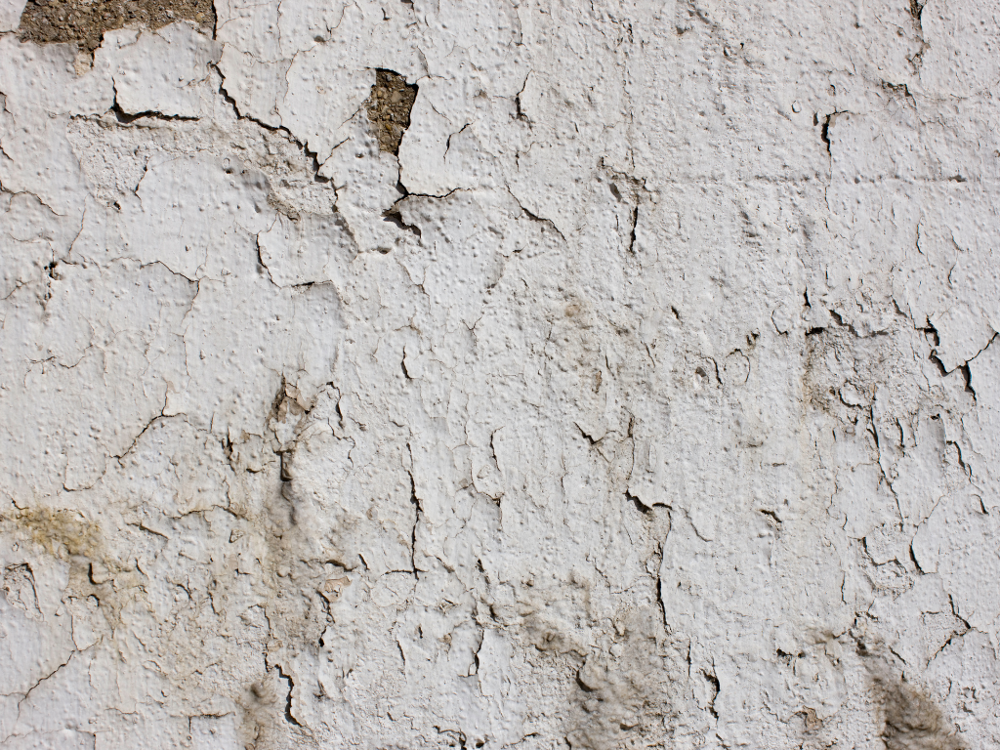
Cracked paint on exterior walls can be a real eyesore that affects thousands of homes across the UK. What is the cause of this cracking and how to prevent it from happening are two very common questions our team of experts are asked, which is why we have put together this guide that contains everything you need to know.
What Causes Cracked Paint?
When it comes to exterior paint, there are many more things that can cause the paint to fail in comparison to an internal emulsion.
Naturally, exterior surfaces are subject to a much wider variety of conditions than standard internal paints, with seasonal changes being the most commonly attributed cause of cracked paint. In reality, there are many more reasons and much more to the story than this alone.
Here are the most common reasons behind cracked paint and how to identify them.
MOISTURE
Moisture and exterior paint are two things that go hand-in-hand. Masonry paints are specifically designed for use on exterior walls such as brick, stone, concrete and render. Not only are they developed in order to adhere to these surfaces, they are also formulated to better resist the weathering that exterior paints must endure.
There are two ways that moisture can result in cracked paint. The first way involves the application and drying process of the paint. The vast majority of masonry paints are water-based, meaning they use water as a solvent that evaporates when the paint dries, leaving behind a dry paint film on the wall. If the paint is applied to a damp surface or in temperatures below 5°C, the water is not able to evaporate effectively in order for the paint to dry. This can lead to the paint cracking due to its inability to dry properly.
The other way that moisture can lead to cracked paint is from weathering. Contrary to popular belief, not all exterior masonry paints are waterproof. Many refer to themselves as ‘weather resistant’ or ‘weatherproof’, however this does not mean they prevent water absorption. To be waterproof a paint must be ‘water repellent’ and therefore repel water away from the surface.
Most masonry paints are not water repellent and can allow moisture to enter the wall. This causes a problem when the moisture becomes trapped once it has entered the wall, due to modern masonry paints having poor breathability.
Breathability refers to the ease in which water vapour can naturally breathe out of a substrate. The lower the breathability of a paint, the harder it is for the moisture to escape and the more risk there is that the moisture becomes trapped. If a paint has low breathability, moisture builds-up underneath the paint film until eventually it begins to force the paint away from the wall.
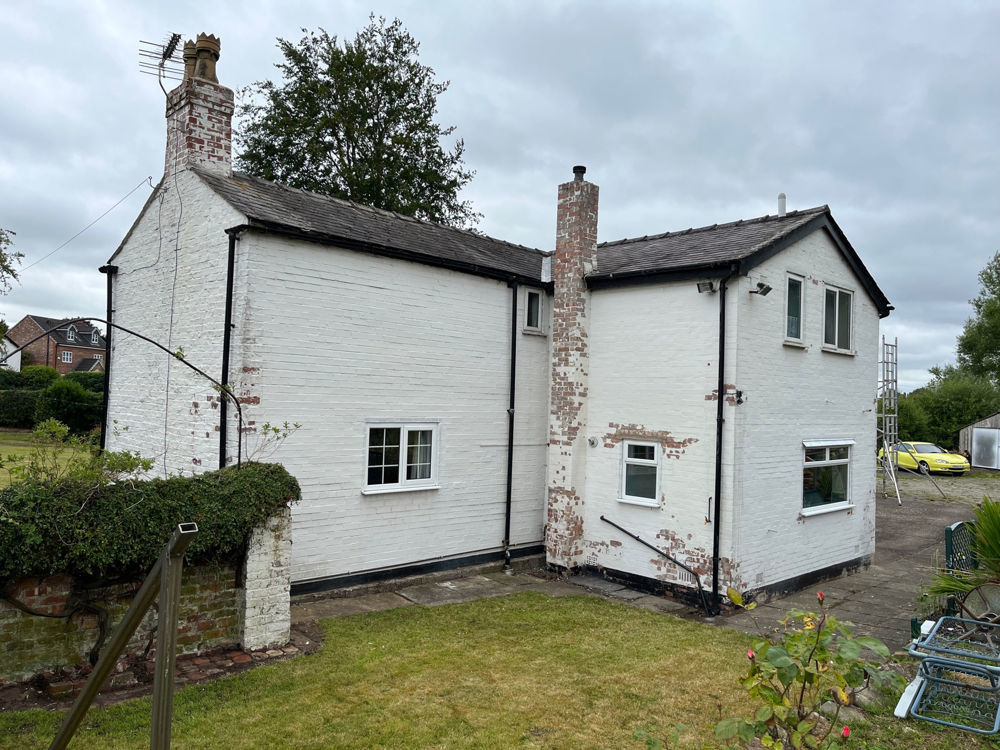
POOR PREPARATION
With any paint, not preparing the surface adequately can result in the paint failing.
In most cases poor preparation comes in the form of not cleaning walls first before painting them. Exterior walls can become full of dirt, grime and organic growth over-time and this must be removed before you apply a paint. If you do not clean the surface, the dirt can impact the adhesion the paint creates with the wall.
The other step that is often missed when painting exterior walls is priming. A primer is required on any bare, unpainted surface before you apply a masonry paint. The primer not only ensures the porous masonry does not absorb the first coat of paint but also helps the first coat stick to the wall. If you do not apply a primer, the paint may begin to crack as it struggles to form a strong bond with the exterior wall.
POOR APPLICATION
We’ve all been there. Time is running out and you want to finish your decorating project as soon as possible. Unfortunately, in some cases application error can also cause paint to fail.
When paint is applied too thickly, the paint film can begin to show small cracks across the surface. This is known as ‘crazing’ or ‘crocodiling’, due to the scale-like cracking that appears on the surface of the paint. This is caused when the moisture that is attempting to evaporate forces its way out of the surface due to the overly thick paint film that has been created.
The result is a poor finish which generally will not fail completely but will need sanding back to a smooth finish and re-coated with another coat of paint to repair.
Although this is rare, it is important to ensure that whatever paint you are using, you read the manufacturer’s instructions to ensure you are applying it how it is designed. This is also more common on textured surfaces as it can be more difficult to evenly spread the paint across the textured finish. Diluting your first coat with water can help reduce this, however simply taking the time to spread the paint evenly is the only way to prevent crazing.
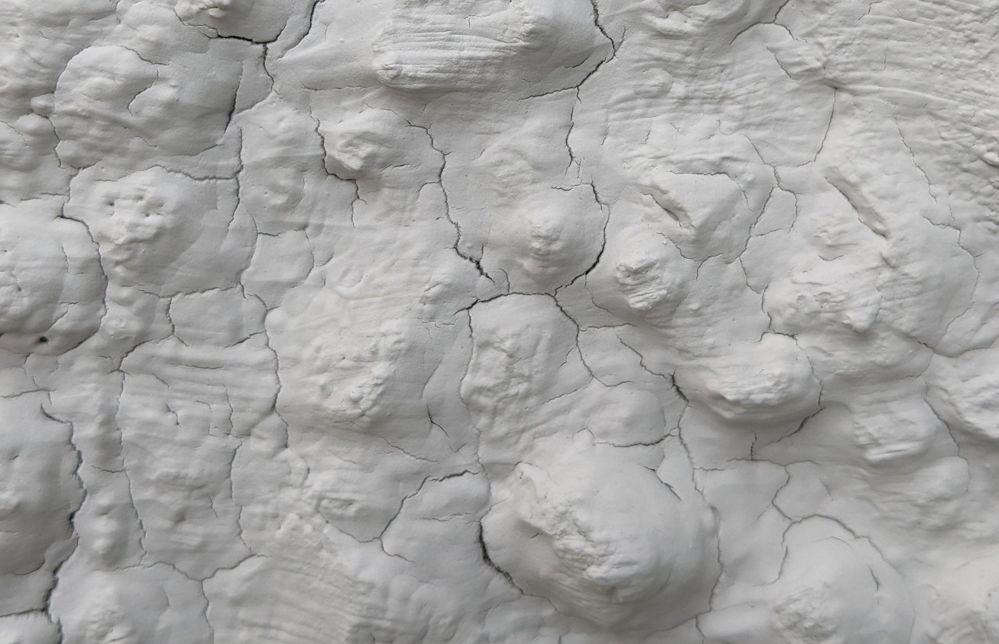
How Do You Prevent Paint Cracking?
When going to the trouble of repairing cracked paint, you want to ensure that you prevent it happening again. By taking the correct steps in applying the paint, you can reduce the risk of paint cracking substantially.
Here are five things to remember:
- Ensure the surface you are painting is dry to the touch with no visible moisture on the surface
- Ensure temperatures are above 5°C
- If you are painting any bare, unpainted surfaces ensure you apply a primer first so that the paint can adhere properly
- Apply the paint according to the manufacturer’s instructions, taking care to apply the paint at the advised coverage rate
If you have experienced cracking due to weathering, this indicates that your home is particularly prone to moisture.
The vast majority of paint failure is due to moisture, meaning using a paint that manages moisture levels effectively is crucial for results that stand the test of time. While saving money by opting for a cheaper paint is often tempting, this is often a false economy as you may spend more long-term having to repaint the wall when this eventually fails.
Standard masonry paints aren’t designed to resist cracking long-term and may need reapplying after 1-5 years in some cases. This is why Emperor Masonry Paint was developed, which is designed for use on any exterior wall including brick, stone & render. It uses highly advanced nano-technology which lines the pores of masonry without sealing them. This means that it creates a super hydrophobic (ultra water repellent) surface on the wall while also remaining highly breathable. While water simply forms ‘beads’ on the wall and rolls off, water vapour that naturally builds-up within a property can freely escape, keeping the exterior wall dry and protected.
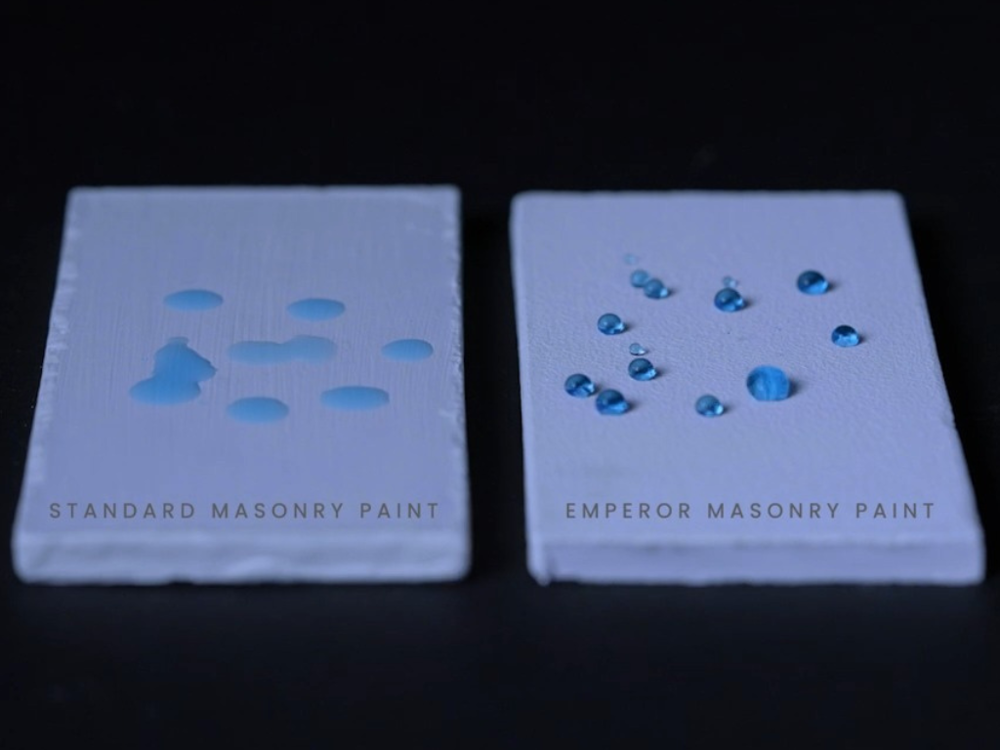
The result is that moisture does not build-up underneath the paint film and cause it to fail, giving the paint extreme durability in all weather conditions.
Emperor Masonry Paint was subjected to 25 years accelerated weathering by an independent UKAS accredited laboratory. After the 25 years equivalent weathering, there was ‘no signs of deterioration in performance or appearance’. Due to this, Emperor Masonry Paint comes with a lifetime guarantee, meaning you can put your mind at ease knowing your home is protected for years to come.
How To Fix Cracked Paint
The process of fixing cracked paint can be done by anyone following our easy step-by-step guide. As with any decorating project, the key is to take your time and ensure all steps are taken as this will give you results that last.
YOU WILL NEED
- Paint scraper
- Exterior filler & filling knife (may be required)
- 120 grit sandpaper
- Paint tray or scuttle
- Paint brush
- Dust sheets
- Masking tape
- Masonry paint
- Masonry primer
1. PREPARATION
When you have suffered from cracked paint, preparation is crucial. This is because there may be other issues that have been caused by the same thing that caused the paint to crack in the first place.
The first job is to remove all of the failing paint. This means any paint that is not soundly adhered to the wall and that can be easily removed. Simply remove the loose or flaking paint with a scraper or wire brush until you have what is known as a ‘firm edge’, where no more paint is coming off the wall.
On the edges where the paint has been removed use sandpaper to feather the edge. This will help to hide any areas you have removed paint by removing the lip between the painted and bare areas.
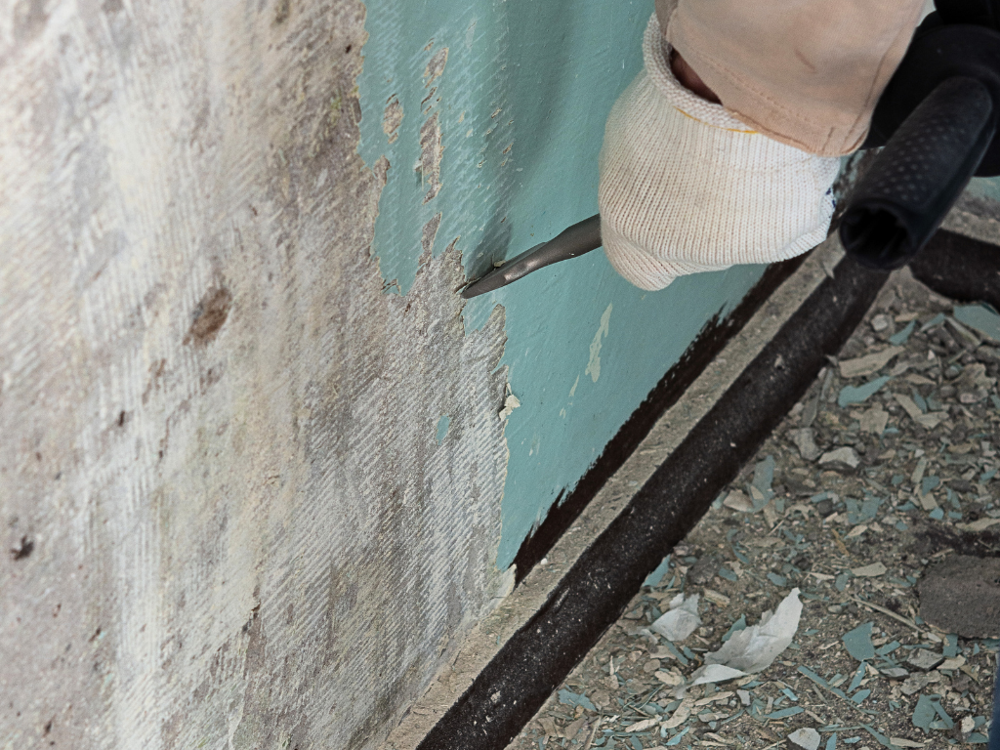
Once you have removed all loose and flaking paint, you can then clean the surface. This may dislodge other areas of failing paint that you may not have spotted when removing the cracked paint.
Firstly, wash the walls down using a hose-pipe or a pressure washer on a low pressure. On any areas where you are suffering from organic growth such as algae, mildew or moss, apply a fungicidal masonry cleaner such as Emperor Masonry Cleaner. Simply apply the cleaner with a brush or roller and allow it to dry for a minimum of 2 hours or until the surface is touch dry.
If you have suffered from cracked paint, this may indicate there was a moisture issue on the wall that could have resulted in other problems such as cracks. Cracks, holes and other defects must be repaired in order to prevent moisture entering the wall. Using a good-quality exterior filler such as Toupret Masonry Repair Filler fill the defects and allow to dry completely. You can then sand the repair back until you achieve a neat, seamless repair.
The final part of the preparation process is to apply a primer to the bare, unpainted areas of the wall. Applying a primer is required on any unpainted surface as it ensures the paint can adhere properly. Ensure you use a primer that is designed for the paint you are going to use, as this will help prevent any risk of failure.
2. PAINTING
When you have prepared the surface, you can then apply a masonry paint to restore your exterior walls back to their former glory. We recommend using a combination of a long-pile roller and a masonry brush in order to paint exterior walls.
Starting at the top, cut in around the edges of the wall and any windows using your paint brush. Once this is done, use your long-pile roller to paint the rest of the surface, working the roller in long, vertical strokes.
You can often dilute your first coat of paint with water, which helps to apply the paint especially on textured surfaces. This dilution ratio will depend on the paint, but is often 10% water by volume.
Leave the first coat to dry properly before you apply the second coat. This can take up to 8 hours but be sure the check the instructions of the masonry paint you are using.
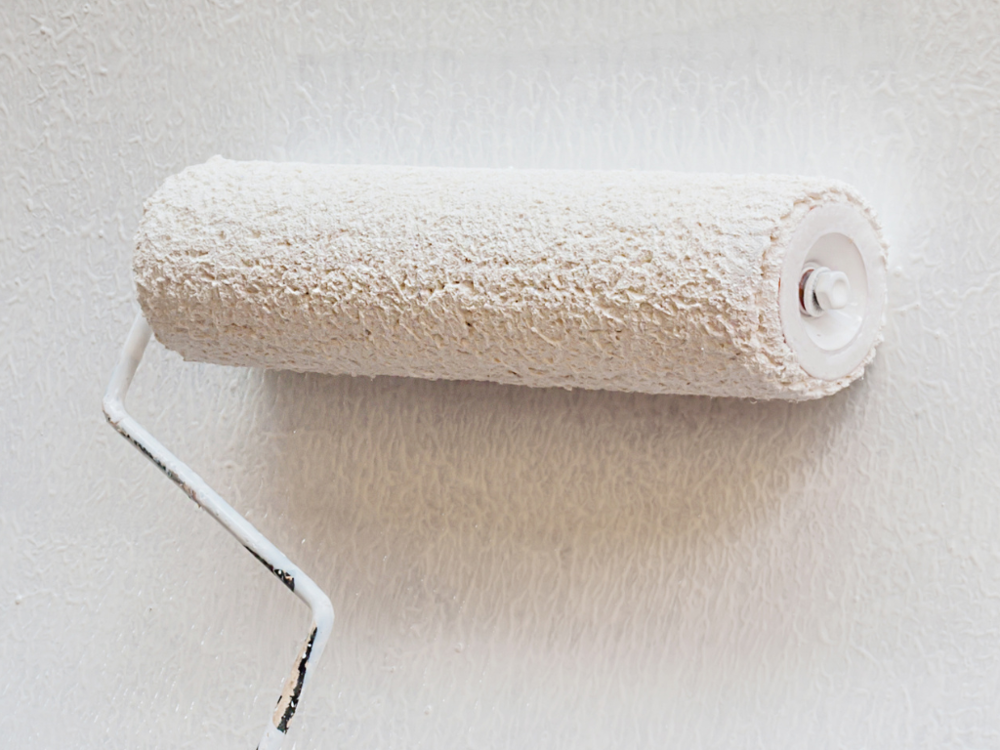
We hope we have answered any questions you may have had regarding cracked paint on exterior walls, what causes it and how to fix it. If you have any other questions or would like advice, feel free to get in touch with our team of experts who are on hand to assist you. Contact them today by emailing [email protected] or calling them on 01254 936121. If you are ready to say bye to cracked paint for good, order your colour card of Emperor Masonry Paint today.

